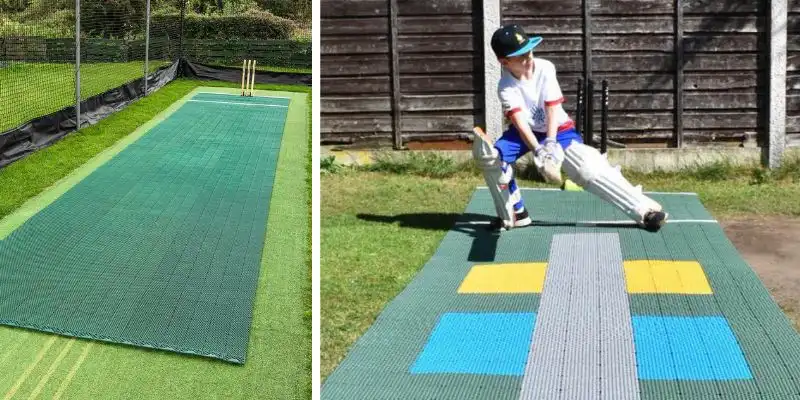The Pros and Cons of Practicing on a Cricket Mat (Find here)
Published: 2 Jun 2025
When I was 13, our school didn’t have a turf pitch. All we had was a rough concrete patch and a few cricket mats rolled up in a corner. At first, I didn’t care much about them. To me, they were just “something to stop the ball from bouncing weirdly.”
But over time, I realized that cricket mat is much more than just a playing surface. They’re silent coaches—steady, reliable, and brutally honest. They tell you where you’re going wrong. And if you listen carefully, they help you get better.

More Than Just a Surface
Most people think a cricket mat is just there for a bounce. But it does more than that.
- It teaches you control—you can’t blame the pitch anymore.
- It helps you build muscle memory because the surface stays the same.
- It forces you to focus on technique, not luck.
If you’ve ever batted on patchy ground, you know the pain. You never know what the next delivery is going to do with you. A cricket mat removes those surprises. Now, it’s just you, the bat, and your skills.
Turf vs Mat – The Truth Nobody Talks About
Everyone dreams of playing on turf. It’s beautiful, sure. But turf isn’t always better for learning, nor is a good practice surface available everywhere.
When you’re working on:
- Your front foot movement
- Your bat swing
- Or landing your spinners on a spot
…you need a consistent bounce. You need repetition.
A mat gives you that.
I’ve seen bowlers improve their yorkers just by drawing a chalk box at the batsman’s end.
Over time, they learn how to land the ball there, again and again.
No drama. Just focus.
The Mat That Tells the Truth
Here’s the part that surprised me the most: a cricket mat doesn’t lie.
It shows you what you’re doing wrong. Fast.
If your footwork is lazy, you’ll feel it.
If your bat comes down late, the ball will hit your pad.
If your length is off, the mat makes it clear.
You can’t blame the pitch. You can’t blame the ball.
It’s just you—and that’s exactly how improvement starts.
Mat + Mindset: Training Smarter
Here are 3 things I personally use during solo sessions:
- Target Zones for Bowlers
- I use duct tape or chalk to draw a small box. That’s my aim.
- Helps with accuracy and control.
- Footwork Lanes for Batting
- I mark lines on the mat to track where my front foot lands.
- Perfect for drills like front-foot defense or on-drive practice.
- Shadow Batting with Mat Feel
- Even without a ball, batting on the mat helps build that crisp, dry “pop” sound when your bat meets the surface.
- It’s good feedback. It tells you when your timing is right.
Backyard Cricket Mat Setup
Setting up a plastic cricket mat—like the Fortress one—in your backyard sounds simple, but if you want long-term use, there are a few things you should know that many first-timers miss.
I’ve gone through this setup myself, and here’s a mix of what I’ve learned personally and what others have shared on forums like Reddit and Quora.
Get Your Base Right — Level, Firm, and Flat
The mat is only as good as the ground under it. If your backyard has soft grass, trimming it won’t be enough.
Real Tip from Real People Reddit/Quora:
“Obviously the flatter the ground is, the better. If you’re planning on having it out a fair bit, it’s gonna kill the grass anyway, so you might as well strip the grass and get some crusher dust or similar compacted flat.”
That’s exactly what I did. I stripped the grass and laid down a 2-3 inch bed of crusher dust, compacted with a plate compactor. It’s non-porous and doesn’t shift easily, even with regular bowling machine sessions.
Mat Movement & Safety
Plastic cricket mats tend to shift a little, especially with powerful bowling machines like the Leverage RoboArm or SpeedArm.
Here’s what helps:
- Peg the mat down at the corners.
- Lay sandbags or rubber tiles on the edges.
- Add anti-slip matting underneath if the base is still soft.
I used tent pegs and placed two gym tiles at each end. That helped a lot when I was batting solo against the Leverage machine.
Summary – What You’ll Need
Minimum for a solid backyard setup:
- Strip the grass and level the area
- Add and compact 2–3 inches of crusher dust
- Optional: Mix in 1–2 bags of dry concrete if you want extra firmness
- Peg or weigh down the mat to prevent sliding
- Make sure your mat size matches your net or space limits
That’s the basic method most groundskeepers recommend for keeping a cricket mat flat and secure.
Worried About Rain? Stabilize the Base
If you’re planning to keep the mat laid out for 6-7 months, occasional rain will soften regular dirt or grass.
Here’s the community-backed advice:
Pro Tip:
“Crusher dust is non-porous, so rain won’t affect it like sand would. But if you’re worried, you could mix in a bag or two of dry concrete to help bind it together.”
Caution: Once you mix concrete, don’t expect to grow grass there again. This is a near-permanent fix. So if you’re planning to return it to a lawn later, this step isn’t for you.
How to re-stick a cricket mat?
- Clean the surface – brush off dirt and lift the loose edge.
- Use the right glue – outdoor carpet adhesive or turf glue works best.
- Press and weight – apply glue, press the mat down, and keep it weighted until dry.
- Extra hold – if needed, secure edges with pins, screws, and washers.
Pros and Cons of a Cricket Mat
Like every piece of gear, cricket mats come with upsides and downsides. Here’s a quick breakdown to help you weigh things before you roll one out:
Pros
- Consistent Bounce: Great for building confidence in footwork and timing.
- Portable Practice: Roll it out anywhere—rooftops, driveways, or school yards.
- Safe Training: Fewer chances of ankle twists or misjudged bounce injuries.
- All-Weather Friendly: Synthetic mats work even in dusty or wet conditions.
- Great for Solo Drills: Ideal for target practice and repetition-based learning.
Cons
- Doesn’t Mimic Turf Perfectly: Ball behavior can feel slightly artificial compared to natural grass.
- Can Wear Out: Cheap mats can tear or lose grip over time.
- Needs a Flat Base: You’ll still need a concrete or level ground under it.
- Storage Can Be Tricky: Long mats can be bulky if not foldable.
Buying One? Match It With Your Game
Not all mats are the same. Here’s what I’ve learned over the years:
- Coir Mats
- Good for bounce and grip. Tougher, but heavier.
- Best for school nets or permanent setups.
- Synthetic Mats
- Lighter and easier to clean.
- Great for rooftops, driveways, or home setups.
- Rubber Backed Mats
- Don’t slide much. Safer for kids and beginners.
Tip: If you train in a small space, get a foldable or cut-size mat. It saves space and is easier to roll up.
Final Over: Why This Mat Matters More Than You Think
Cricket isn’t always played in stadiums. Sometimes it starts in a small backyard. Or a schoolyard. Or a rooftop.
That’s where cricket mats become more than equipment.
They become spaces where dreams grow quietly, where footwork is learned, where line and length are perfected, where confidence is built.
So next time you see a rolled-up mat, remember—it could be the most honest coach you’ll ever have.
Bonus: 3 Quick Solo Drills You Can Do on a Cricket Mat
- Bowler’s Block Drill
- Place a small object (like a towel) on a good length area.
- Try to hit it 6 times in a row.
- One-Step Batting Drill
- Use one-step footwork to practice balance while batting on the mat.
- Spin Zone Practice
- Mark a zone for spin bowlers to drop the ball.
- Use this to perfect flight and turn.
Want more tips, or curious about which mat suits your setup best?
Just ask—I’d be happy to help. 🏏

- Be Respectful
- Stay Relevant
- Stay Positive
- True Feedback
- Encourage Discussion
- Avoid Spamming
- No Fake News
- Don't Copy-Paste
- No Personal Attacks

- Be Respectful
- Stay Relevant
- Stay Positive
- True Feedback
- Encourage Discussion
- Avoid Spamming
- No Fake News
- Don't Copy-Paste
- No Personal Attacks





